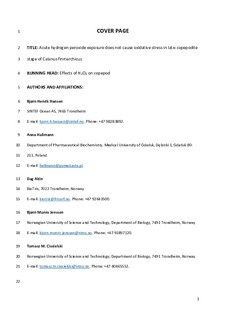Acute hydrogen peroxide (H2O2) exposure does not cause oxidative stress in late-copepodite stage of Calanus finmarchicus
Journal article, Peer reviewed
Accepted version
Permanent lenke
http://hdl.handle.net/11250/2460810Utgivelsesdato
2017Metadata
Vis full innførselSamlinger
- Institutt for biologi [2575]
- Publikasjoner fra CRIStin - NTNU [38127]
Originalversjon
10.1080/15287394.2017.1352182Sammendrag
Use of hydrogen peroxide (H2O2) for removal of salmon lice in the aquaculture industry has created concern that non-target organisms might be affected during treatment scenarios. The aim of the present study was to examine the potential for H2O2 to produce oxidative stress and reduce survival in one of the most abundant zooplankton species in Norwegian coastal areas, the copepod Calanus finmarchicus. Copepods were subjected to two 96-hr tests: (1) acute toxicity test where mortality was determined and (2) treated copepods were exposed to concentrations below the No Observed Effect Concentration (0.75 mg/L) H2O2 and analyzed for antioxidant enzyme activities, as well as levels of glutathione (GSH) and malondialdehyde (MDA). Compared to available and comparable LC50 values from the literature, our results suggest that C. finmarchicus is highly sensitive to H2O2. However, 96-hr exposure of C. finmarchicus to 0.75 mg H2O2/L did not significantly affect the antioxidant systems even though the concentration is just below the level where mortality is expected. Data suggest that aqueous H2O2 exposure did not cause cellular accumulation with associated oxidative stress, but rather produced acute effects on copepod surface (carapace). Further investigation is required to ensure that aqueous exposure during H2O2 treatment in salmon fish farms does not exert adverse effects on local non-target crustacean species and populations. In particular, studies on copepod developmental stages with a more permeable carapace are warranted.
